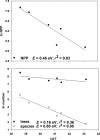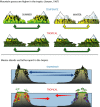Why are there so many species in the tropics?
- PMID: 25684838
- PMCID: PMC4320694
- DOI: 10.1111/jbi.12228
Why are there so many species in the tropics?
Abstract
Known for centuries, the geographical pattern of increasing biodiversity from the poles to the equator is one of the most pervasive features of life on Earth. A longstanding goal of biogeographers has been to understand the primary factors that generate and maintain high diversity in the tropics. Many 'historical' and 'ecological' hypotheses have been proposed and debated, but there is still little consensus. Recent discussions have centred around two main phenomena: phylogenetic niche conservatism and ecological productivity. These two factors play important roles, but accumulating theoretical and empirical studies suggest that the single most important factor is kinetics: the temperature dependence of ecological and evolutionary rates. The relatively high temperatures in the tropics generate and maintain high diversity because 'the Red Queen runs faster when she is hot'.
Keywords: Ecological interactions; Janzen–Connell dynamics; Red Queen; evolutionary rates; latitudinal diversity gradient; metabolic theory; species diversity; tropics.
Figures


 , turnover rate of species.
, turnover rate of species.
References
-
- Adams RI. Hadly EA. Genetic diversity within vertebrate species is greater at lower latitudes. Evolutionary Ecology. 2012;27:133–143. &.
-
- Allen AP. Gillooly JF. Assessing latitudinal gradients in speciation rates and biodiversity at the global scale. Ecology Letters. 2006;9:947–954. &. - PubMed
-
- Allen AP, Brown JH. Gillooly JF. Global biodiversity, biochemical kinetics, and the energetic-equivalence rule. Science. 2002;297:1545–1548. &. - PubMed
-
- Allen AP, Gillooly JF. Brown JH. Linking the global carbon cycle to individual metabolism. Functional Ecology. 2005;19:202–213. &.
Grants and funding
LinkOut - more resources
Full Text Sources
Other Literature Sources
